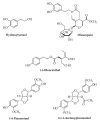Health Effects of Phenolic Compounds Found in Extra-Virgin Olive Oil, By-Products, and Leaf of Olea europaea L
- PMID: 31374907
- PMCID: PMC6724211
- DOI: 10.3390/nu11081776
Health Effects of Phenolic Compounds Found in Extra-Virgin Olive Oil, By-Products, and Leaf of Olea europaea L
Abstract
Olea europaea L. fruit is a peculiar vegetal matrix containing high levels of fatty acids (98-99% of the total weight of extra-virgin olive oil, EVOO) and low quantities (1-2%) of phenolics, phytosterols, tocopherols, and squalene. Among these minor components, phenolics are relevant molecules for human health. This review is focused on their beneficial activity, in particular of hydroxytyrosol (HT), oleuropein (OLE), oleocanthal (OLC), and lignans found in EVOO, olive oil by-products and leaves. Specifically, the cardioprotective properties of the Mediterranean diet (MD) related to olive oil consumption, and the biological activities of polyphenols recovered from olive oil by-products and leaves were described. Recent European projects such as EPIC (European Prospective Investigation into Cancer and Nutrition) and EPICOR (long-term follow-up of antithrombotic management patterns in acute coronary syndrome patients) have demonstrated the functional and preventive activities of EVOO showing the relation both between cancer and nutrition and between consumption of EVOO, vegetables, and fruit and the incidence of coronary heart disease. The data reported in this review demonstrate that EVOO, one of the pillars of the MD, is the main product of Olea europaea L. fruits; leaves and by-products are secondary but precious products from which bioactive compounds can be recovered by green technologies and reused for food, agronomic, nutraceutical, and biomedical applications according to the circular economy strategy.
Keywords: Olea europaea L.; circular economy; extra-virgin olive oil; health effects; hydroxytyrosol; lignans; oleocanthal; oleuropein; olive oil by-products; olives leaf; phenolic compounds.
Conflict of interest statement
The authors declare no conflicts of interest.
Figures





References
-
- Bosku D. Olive Oil. In: Simopoulos A.P., Visioli F., editors. Mediterranean Diets. Karger Publishers; Basel, Switzerland: 2000. pp. 56–77.
-
- Nocella C., Cammisotto V., Fianchini L., D’Amico A., Novo M., Castellani V., Stefanini L., Violi F., Carnevale R. Extra Virgin Olive Oil and Cardiovascular Diseases: Benefits for Human Health. Endocr. Metab. Immune Disord. Drug Targets. 2018;18:4–13. doi: 10.2174/1871530317666171114121533. - DOI - PubMed
-
- Codex Alimentarius-International Food Standards. [(accessed on 4 April 2019)]; Available online: http://www.fao.org/fao-who-codexalimentarius/en/
-
- López-Biedma A., Sánchez-Quesada C., Delgado-Rodríguez M., Gaforio J.J. The biological activities of natural lignans from olives and virgin olive oils: A review. J. Funct. Foods. 2016;26:36–47. doi: 10.1016/j.jff.2016.07.005. - DOI
Publication types
MeSH terms
Substances
LinkOut - more resources
Full Text Sources
Other Literature Sources

